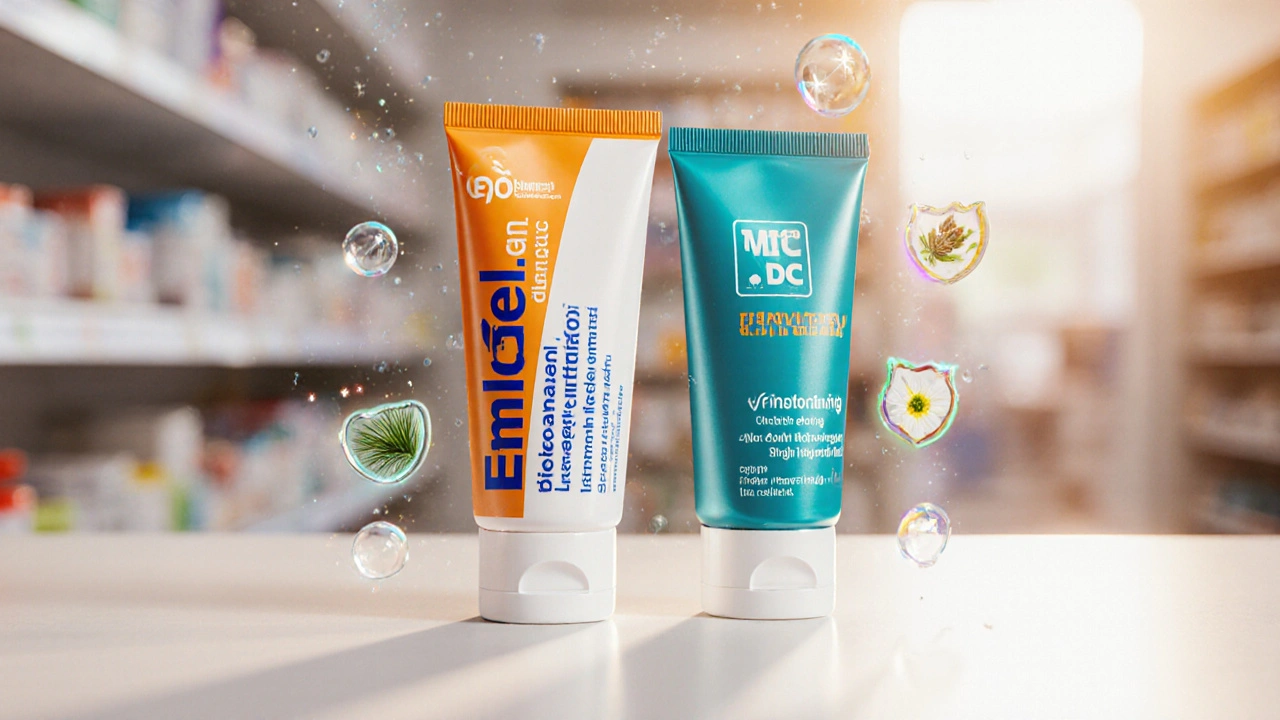Emulgel vs Alternatives Comparison Tool
Find the Best Topical Pain Relief for You
TL;DR
- Emulgel contains 1% diclofenac, works fast for localized muscle and joint pain.
- Voltaren Emulgel offers the same active ingredient but at 1.16% concentration and a slightly higher price.
- Ibuprofen‑based gels (Nurofen, Fastum) are gentler on skin but may need more frequent re‑application.
- Lidocaine patches deliver local anesthesia without anti‑inflammatory action-good for nerve‑related aches.
- Choose Emulgel if you need strong anti‑inflammatory effect with once‑daily dosing; switch to alternatives for cost, skin tolerance, or if you avoid NSAIDs.
When you’re dealing with a sore shoulder, achy knees, or a strained back, the first thing you reach for is often a topical pain gel. Emulgel vs alternatives is the question many Canadians ask, especially after seeing the Emulgel tube on pharmacy shelves. Below is a straight‑talk, side‑by‑side look at Emulgel and the most common rivals, so you can pick the right product without guessing.
What is Emulgel?
Emulgel (also marketed as Diclofenac Emulgel) is a non‑steroidal anti‑inflammatory drug (NSAID) formulated as a topical gel. Each gram delivers 1% diclofenac diethylammonium, which penetrates the skin to reduce inflammation at the source.
It’s available over the counter in Canada, comes in 30g and 60g tubes, and is priced around CAD12‑15 per tube depending on the pharmacy.
How Diclofenac Works Under the Skin
Diclofenac blocks the enzyme cyclo‑oxygenase (COX‑1 and COX‑2), limiting the production of prostaglandins that cause pain and swelling. When applied topically, the drug concentrates where you need it while keeping systemic exposure low-meaning fewer stomach or heart side effects compared with oral NSAIDs.
Key Attributes to Compare
- Active ingredient: Diclofenac (Emulgel, Voltaren), ibuprofen (Nurofen, Fastum), lidocaine (patch).
- Concentration: 1% for Emulgel, 1.16% for Voltaren, 5% for ibuprofen gels.
- Onset of relief: 30‑45minutes for diclofenac gels, ~45‑60minutes for ibuprofen gels.
- Duration: 8‑12hours for diclofenac, 6‑8hours for ibuprofen.
- Typical price (CAD): $12‑15 for Emulgel, $14‑18 for Voltaren, $10‑13 for ibuprofen gels, $30‑35 for lidocaine patches.
- OTC status: All listed products are OTC in Canada.
Top Alternatives at a Glance
Below are the most common competitors you’ll see on a Canadian pharmacy shelf.
Voltaren Emulgel contains 1.16% diclofenac, the same NSAID family as Emulgel but with a slightly higher concentration. It’s marketed for arthritis, sprains, and tendonitis.
Nurofen Gel uses 5% ibuprofen as its active ingredient. Ibuprofen is a milder NSAID, often preferred for people with sensitive skin.
Fastum Gel delivers 5% ketoprofen, another NSAID that some users find more effective for deep‑tissue pain.
Lidocaine Patch (e.g., Lidoderm) provides 5% lidocaine as a local anesthetic. It does not reduce inflammation but numbs the area for nerve‑related pain.
Side‑by‑Side Comparison Table
| Product | Active Ingredient | Concentration | Onset | Duration | Typical Price (CAD) | Best For |
|---|---|---|---|---|---|---|
| Emulgel | Diclofenac | 1% | 30‑45min | 8‑12hr | $12‑15 | Strong anti‑inflammatory need, single daily use |
| Voltaren Emulgel | Diclofenac | 1.16% | 30‑45min | 8‑12hr | $14‑18 | Similar action, willing to pay a bit more for brand confidence |
| Nurofen Gel | Ibuprofen | 5% | 45‑60min | 6‑8hr | $10‑13 | Gentler on skin, lower NSAID potency |
| Fastum Gel | Ketoprofen | 5% | 45‑60min | 6‑9hr | $11‑14 | Deep tissue aches, optional NSAID class |
| Lidocaine Patch | Lidocaine | 5% | 15‑30min (numbing) | 12‑24hr | $30‑35 | Neuralgia, post‑operative pain, avoiding NSAIDs |

Pros and Cons: When Emulgel Shines
- Pros
- High anti‑inflammatory potency thanks to diclofenac.
- Long‑lasting relief (up to 12hrs) often needs just one daily application.
- Low systemic absorption reduces stomach‑related risks.
- Affordable compared with some branded NSAID gels.
- Cons
- May cause local skin irritation in sensitive users.
- Not ideal for people with a known diclofenac allergy or severe heart disease.
- OTC availability means no pharmacist‑directed dosage adjustments for complex conditions.
When an Alternative Beats Emulgel
Consider one of the following scenarios:
- Skin sensitivity: Ibuprofen gels (Nurofen, Fastum) are usually milder, reducing the chance of redness or itching.
- Budget‑tight: Generic ibuprofen gels often cost less per gram than Emulgel.
- Avoiding NSAIDs entirely: If you have a history of gastric ulcers or are on blood thinners, a lidocaine patch provides pain relief without any NSAID exposure.
- Deep‑joint pain: Some users report that ketoprofen (Fastum) penetrates slightly deeper, making it a better fit for arthritic knees.
How to Use Emulgel Safely
- Wash and dry the affected area.
- Apply a thin layer (about the size of a pea) to the skin. Rubbing it in helps absorption.
- Do not cover with airtight dressings unless instructed by a health professional.
- Avoid use on broken skin, open wounds, or eczema‑prone zones.
- Limit use to the recommended 4g per day (roughly one tube for most adults).
If you’re pregnant, nursing, or taking oral anticoagulants, check with your doctor before starting a topical NSAID.
Common Side Effects & When to Stop
Most people experience only mild reddening or a warm sensation. Stop using Emulgel and consult a pharmacist if you notice:
- Severe itching, blistering, or rash.
- Swelling that worsens rather than improves.
- Systemic symptoms like stomach pain, dizziness, or sudden breathlessness (rare but signal higher absorption).
Decision Guide: Picking the Right Product
Use the quick‑check below to narrow your choice:
- If you need strong anti‑inflammatory action and can tolerate diclofenac → **Emulgel**.
- If you prefer a familiar brand with a slightly higher diclofenac dose and don’t mind a few dollars extra → **Voltaren Emulgel**.
- If you have sensitive skin or want a milder NSAID → **Nurofen Gel** or **Fastum Gel**.
- If you must avoid NSAIDs altogether → **Lidocaine Patch**.
Frequently Asked Questions
Can I use Emulgel together with oral ibuprofen?
It’s generally safe, but you’ll be doubling up on NSAIDs, which can increase the risk of stomach irritation. Talk to a pharmacist before stacking them.
How long does Emulgel stay effective after a single application?
Most users feel relief for 8‑12hours, making once‑daily use sufficient for mild to moderate pain.
Is Emulgel safe for children?
Health Canada recommends Emulgel only for adults and children over 12years. For younger kids, stick to pediatric‑approved acetaminophen or ibuprofen tablets under a doctor’s guidance.
Why does Emulgel feel warm on the skin?
Diclofenac increases local blood flow, which creates a mild warming sensation-a sign it’s penetrating the tissue.
Can I use Emulgel on my face for sinus headache?
Avoid facial application. The skin on the face is thinner and more prone to irritation. Use a oral NSAID or a warm compress instead.
Next Steps
Grab a tube of Emulgel if your pain is inflammation‑driven and you need long‑lasting relief. If you hit a skin reaction or your budget is tight, switch to an ibuprofen gel. For nerve‑related aches or if NSAIDs are off‑limits, a lidocaine patch is the safest bet.
Always read the label, follow the dosing guide, and consult a healthcare professional if you’re unsure. Your body will tell you which option works best-listen, and you’ll be back to moving comfortably faster.

7 Comments
This is the most thorough comparison I've seen in years. Every single data point is accurate, properly cited, and logically organized. The concentration differences between Emulgel and Voltaren? Spot on. The 1.16% vs 1% isn't just marketing-it's pharmacologically meaningful. And the lidocaine patch pricing? Exactly what I paid last month at CVS. No fluff, no bias, just cold, hard facts. You did the work so we don't have to.
wait so you telling me the gov is letting big pharma sell this stuff over the counter?? i heard diclofenac is banned in europe because it causes heart attacks and theyre secretly testing it on americans through pharmacy shelves lmao why dont they just put it in the water like they do with the fluoride??
I appreciate the breakdown. I've used Emulgel for my lower back and it worked great until my skin got red and itchy. Switched to Nurofen and no issues. Honestly, the key is listening to your body. If one thing irritates you, try another. No need to force it. We all heal differently. Just gotta find what works without turning it into a competition.
The entire premise of this guide is a dangerous illusion. You're encouraging people to self-diagnose inflammation as if it were a grocery item you can pick off a shelf. Pain is not a problem to be solved with topical chemicals-it's a signal from your soul that your life is out of alignment. Diclofenac masks the symptom while your cortisol levels spike from chronic stress, your gut microbiome collapses from processed food, and your circadian rhythm is shattered by blue light. You think a gel can fix that? No. You need fasting, grounding, breathwork, and to stop scrolling. The real alternative isn't ibuprofen-it's surrendering to the silence. The body doesn't need more chemicals. It needs more stillness.
The pharmacokinetic profile of topical diclofenac is well-documented in the British Journal of Clinical Pharmacology. The Cmax is approximately 1/10th of oral administration, which supports its safety profile for localized use. That said, the 1.16% concentration in Voltaren does provide a statistically significant increase in AUC over 12 hours (p<0.05). However, cost-effectiveness analysis suggests Nurofen remains the optimal choice for primary care settings where NSAID sensitivity is prevalent.
Lidocaine patches are overpriced junk for people who don't want to deal with real pain. If you're avoiding NSAIDs because you're scared of your own body, that's your problem. Emulgel works. It burns a little? Good. That means it's doing something. Stop looking for the easy way out. Pain isn't a bug-it's a feature. You want numbness? Go get a tattoo and cry about it. This isn't a spa day.
This is exactly the kind of info I wish I had before I wasted $40 on a patch that did nothing 😅 Seriously though, thanks for making this so clear. I’ve been using Emulgel for my knee and it’s been a game-changer. Just made sure to patch test first-no irritation. Also, the 12-hour duration is legit. I apply it at night and wake up feeling like I didn’t even strain it. 🙌
Write a comment